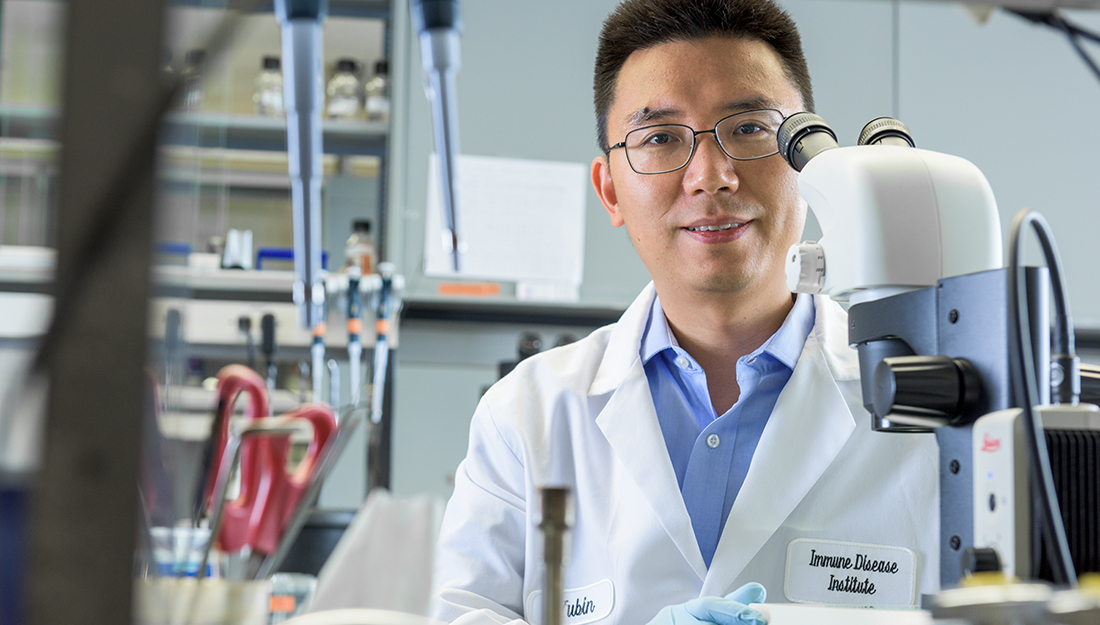- Christina Sumners
- Biosciences & Technology, Medicine, Research, Show on VR homepage
TRIM(ming) away proteins to curtail breast cancer
Discovery of new molecular targets to stop cancer cell metastasis

Yubin Zhou in his lab
Cancer is a leading cause of death globally, with about 1 in 6 deaths due to cancer, according to the World Health Organization. Deaths from cancer often occur due to metastasis, or the migration of the cancer from its original site to nearby tissues and eventually to distant organs in the body.
The recent discovery of a protein called TRIM59 might help scientists find a way to stop the migration of breast cancer cells before it starts. This work, published in the journal PLoS Biology, was led by Yubin Zhou, MD, PhD, associate professor at the Texas A&M Institute of Biosciences and Technology.
Cancer cells change their morphology—in other words, their form and structure—and adopt different migration patterns to metastasize and deprive the human body of the nutrients it needs for survival. Once cancer cells spread, they are extremely difficult to control, and the disease might be put into remission, but can’t generally be cured.
Breast cancer, although not the deadliest, is the most common type of cancer in the United States in 2018. The protein TRIM59 is key to the “migration mode” of breast cancer, promoting its survival and metastasis.
“By combining the Cancer Genome Atlas data and cancer patient samples, we found that TRIM59 is often abnormally upregulated in metastatic breast cancer patients, a feature that is correlated with a poor patient survival,” Zhou said. The bioinformatic and clinical analyses were performed through collaboration with Leng Han, PhD, a bioinformatician at the University of Texas Health Science Center at Houston.
The ability of the cell to change its morphology is vital for cancer cell movement and metastasis, and cancer cells have at least three ways of moving through the body, depending on the surrounding environment and speed of migration.
A group of proteins called tripartite motif (TRIM) family play crucial roles in regulating the stability of critical proteins involved in cell migration. Therefore, the study of TRIM proteins in cancer mobility and metastasis could be a key to stopping cancer cell metastasis.
The researchers further found that TRIM59 directly interacts with PDCD10, a key modulator of a type of signaling that controls cell morphology and cancer cell metastasis. TRIM59 blocks its degradation through autophagy. In addition, when there is a mutation in the gene that produces PDCD10, it causes the devastating familial cerebral cavernous malformations disease.
Think of a breast cancer cell expressing PDCD10 as a moving car. During metastasis, the expression level of PDCD10 decides which mode the cancer cells can adopt to travel to the distant sites: either through Route 59, in which there are high levels of TRIM59 leading to fast metastasis, or Route 62, slow metastasis.
Peng Tan, PhD, a former graduate student at the Institute of Biosciences and Technology, who spearheaded the project, said, “Targeting TRIM59/PDCD10 interplay, therefore, may provide a new way to kill or stop the growth of primary and metastatic cancer cells, and potentially the cerebral cavernous malformation as well.”
These studies were supported by grants from the National Institutes of Health, the Cancer Prevention and Research Institute of Texas (CPRIT), the American Cancer Society and the Welch Foundation.
Media contact: media@tamu.edu


